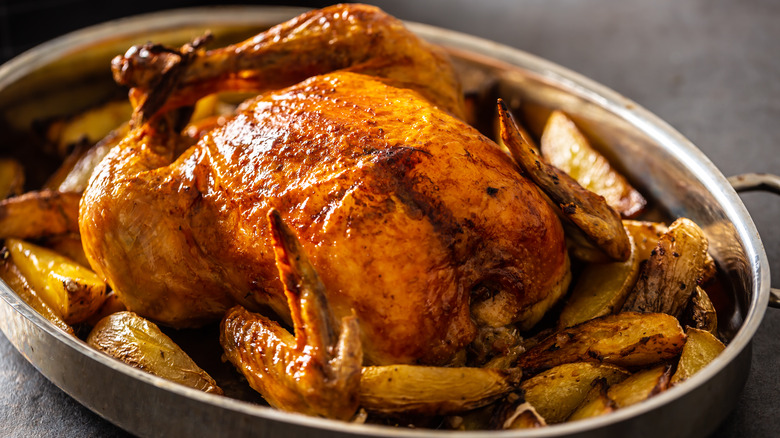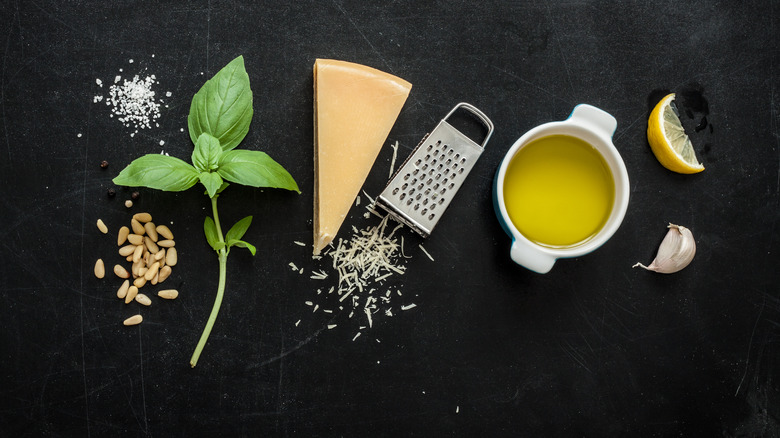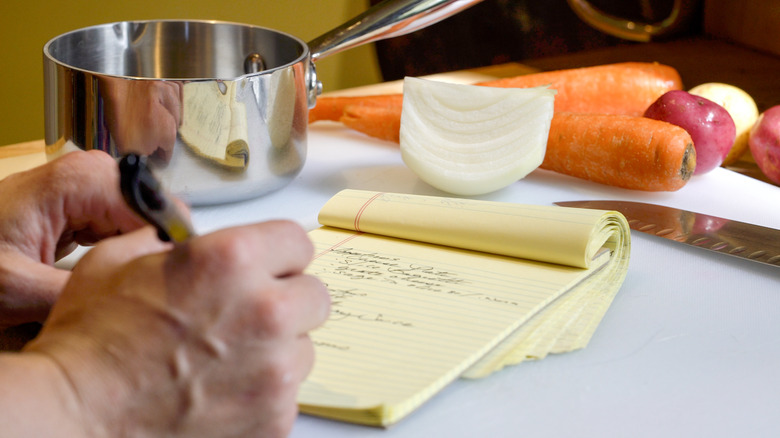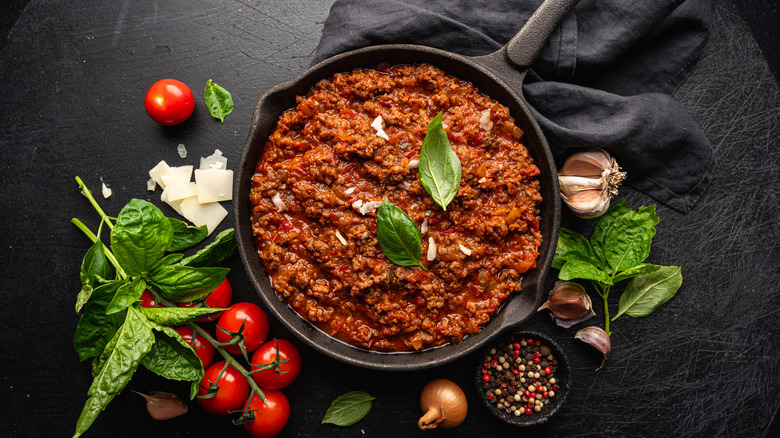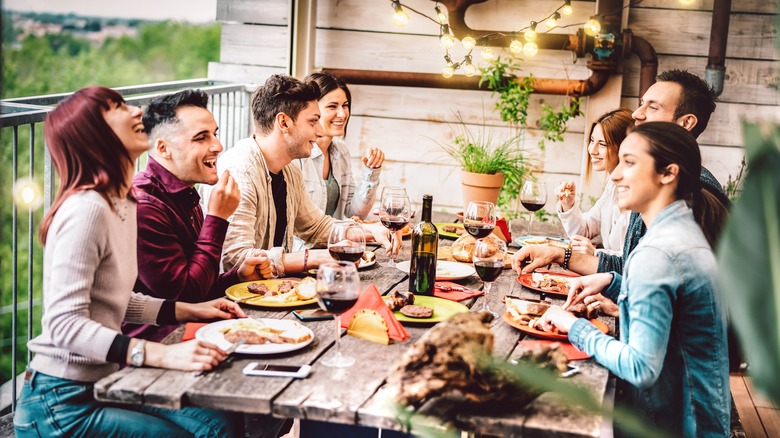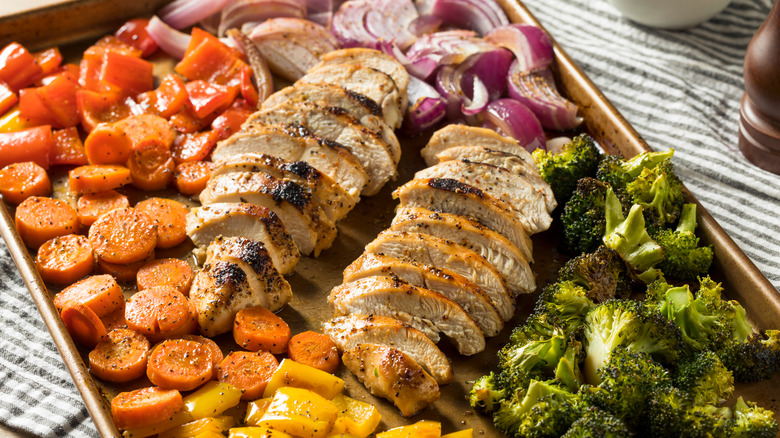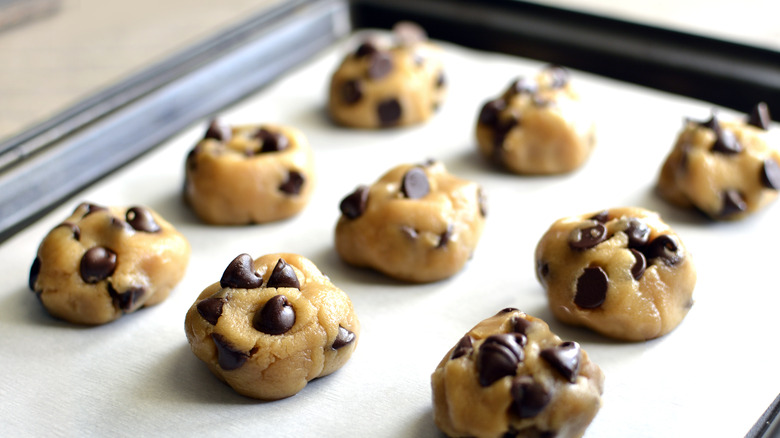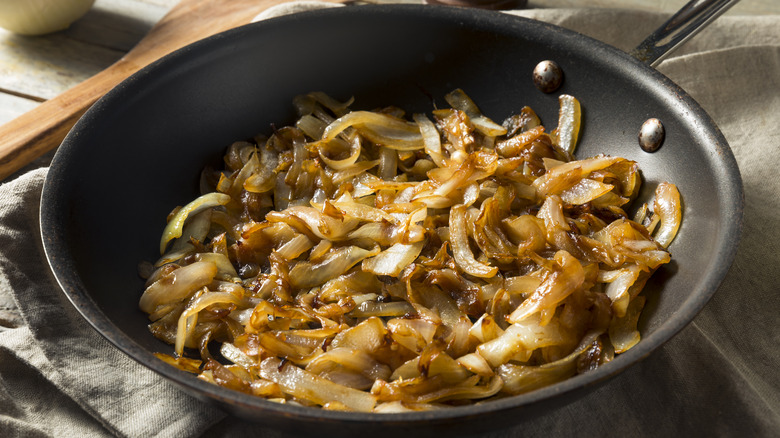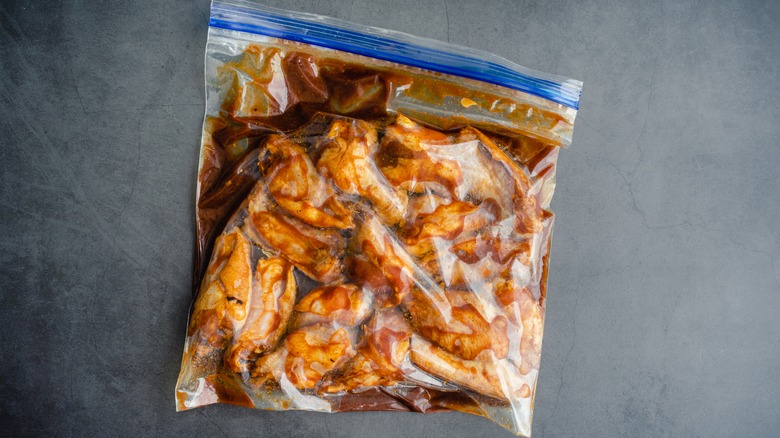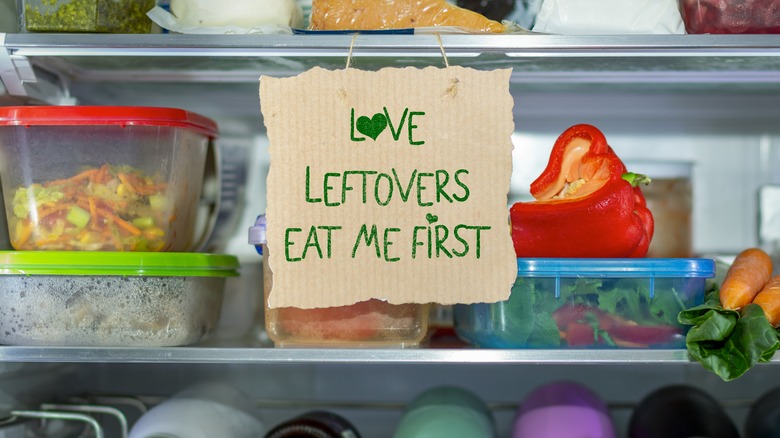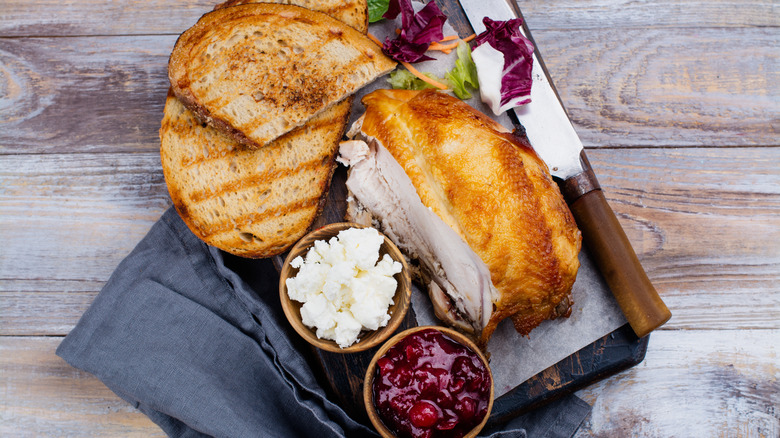Ina Garten's 12 Best Cooking Tips For Home Chefs
You don't become a culinary institution by accident. Ina Garten, one of the most beloved Food Network stars and the author of over a dozen best selling cookbooks, has been a household name since the debut of her television show on the Food Network in 2002 (per IMDB). After 20 years, she has amassed and shared some of the most helpful advice for cooking and hosting dinners, holidays, and parties in the industry. Her approachable methods allow even the novice home chef to present a well-organized and elegant spread to even the most discerning of guests.
She has proven that everyone and anyone can bring elegance to the table. We have collected some of her most practical tips to help you through your next soiree or Wednesday night dinner. Roll up your sleeves, pour a glass of wine, and kick off your shoes as we share some of the best advice from the Barefoot Contessa herself.
Keep it simple
Just because you want to serve up an impressive spread, that doesn't mean that you have to get complicated. One of Ina Garten's main tenants is simplicity (after all, her catch phrase in her show is "Wasn't that easy?"). You don't need to go out to specialty shops to purchase one-use ingredients or break the bank buying a kitchen gizmo that you'll only use once then hide it away on your shelves. Check your pantry.
There's a good chance you might only need to pick up one or two fresh components to make a very memorable meal. Even special-occasion meals like New Year's Eve, can be both elegant and simple with a meal that only requires 10 minutes and three ingredients. Celebrities like Emily Blount and Meghan Markle praise the simplicity of Ina's so-called "engagement chicken," a classic dish comprising only five ingredients (via People). If you keep it simple, you focus on the flavors of the ingredients and don't get lost in complicated recipes, letting the food do all the work.
Be prepared in the pantry
Whether you're a seasoned professional or a novice home cook, it's important to always have a few staples on hand. Ina told Bon Appétit, "There are some things I always have in the house, like a bowl of lemons on the counter (and other citrus), butter, eggs, Parmesan cheese, and chocolate." And if you were to peek into her freezer, you would see Ina Garten keeps four additional "must-haves:" soup, chicken stock, vanilla ice cream, and vodka.
While you might not have use for a full basket of lemons, having citrus, chicken stock, and Parmesan cheese immediately available means you are less than 20 minutes away from a gorgeous weekday dinner of lemon spaghetti. This is one dish you could proudly serve to unexpected guests, or enjoy solo on the couch with your favorite comfort-show. The security of knowing you have the basics in your back pocket will cut down on frantic last-minute shopping trips, which can set you on the best foot forward for the rest of the meal process.
Make a meal plan
Whether you're hosting a multi-generational Thanksgiving dinner, or just a couple of close friends for brunch, it's important to have a plan of action in place. Ina, herself, admits on the Barefoot Contessa website, "Sometimes the hardest thing about a throwing a party is just planning the menu!" You don't want to be stuck in the kitchen, running in five different directions while your guests are socializing (or worse, waiting for food that's still an hour from being done).
Ina goes on to say, "I'll prepare a game plan to make sure I can actually pull it off — something served at room temperature, some things in the oven, some on top of the stove, and hopefully a few dishes that I can assemble in advance so I'm not in a full sweat when my friends arrive!" Make sure to read the recipes that you're planning on making. Take note of how long each dish will take to cook and how they're going to be cooked. Having a plan in place will reduce your stress during the preparation, and it will free you up to enjoy your own party.
Elevate classic recipes
Classics are classics for a reason. From roast chicken to lasagna, certain dishes transcend time and belong in every home cook's rolodex of recipes that can be produced with a certain amount of ease and confidence. However, just because the dishes are classics does not mean that they can't be improved. Ina Garten's Bolognese recipe calls for a double tap of red wine, both at the beginning and at the end of cooking the sauce. Punching up traditional dishes keeps your recipe rotation exciting and allows the home cook to experiment with different twists on tried and true meals.
Even something as simple as steak can be improved and elevated in a myriad of ways with just adding one or two basic ingredients. By continuing to tweak and revisit classic recipes, you can present guests or family members with an approachable main course that packs a personalized twist, ensuring that everyone enjoys their meal.
Don't stray from your culinary comfort zone when hosting
It's easy to get amped up for a brand new recipe that might be a bit of a culinary stretch when you're hoping to make an impression on your guests. Resist the urge and follow Ina Garten's entertaining rule. "It's really about making sure that you're making something that you're comfortable making," Ina said in her interview with Vogue. "So, when everybody arrives, you're relaxed and happy—because that's what makes the best dinner party. Not just for you, but for your guests, as well."
Being a host is about making sure that your guests are comfortable and happy, which you can't do if you're rushing around panicking over an untested or overly-complicated recipe. Even if your comfort zone is recipes at the beginner's level, your party will go smoother for staying within your own boundaries. After all, your friends came to have a cocktail with you, not listen to clattering in the kitchen.
One pan is all you need
One-pan recipes are a god-send for most home chefs. Fewer elements to keep track of and fewer dishes at the end of the night. No one wants to have to deal with multiple pans on the stove making an elaborate dinner in the middle of the workweek. In her book "Go-To Dinners," Ina Garten offers up several one-pan recipes, inspired by her own fatigue that came during the pandemic (per Vogue).
Break out your sheet pans or trusty cast iron skillet and give yourself a much needed cooking vacation by adding vegetables and proteins all at once. But, according to tried-and-true Barefoot Contessa hosting tips, just because it's simple doesn't mean it has to be bland. Ina's one-pan chicken trick calls for laying sliced potatoes under the chicken to absorb the fonds and the juices from the bottom of the pan, ensuring that every element of the meal is delicious.
The freezer is your friend
The freezer isn't just an elaborate ice-cream holder (although, there's no shame in a cheeky pint or two tucked between the frozen spinach). Believe it or not, but the temperature of food when it hits a hot pan or oven can make a true difference in how it cooks. Ina Garten recommends a 15-minute foray into the freezer for both chocolate chip cookie dough and homemade hamburger patties.
When you allow your food to chill for a short amount of time, you are ensuring a uniform temperature when it goes to cook. This means that your food will cook through evenly, making perfectly textured cookies and juicy burgers. Don't be afraid to let your food rest in the freezer while you clean up your work space or tackle a few dishes. Your meals will be better for it and your after-dinner clean up will already be started.
Patience makes perfect
When it comes to things like resting your cookie dough in the freezer for 15-minutes or caramelizing onions, there's no substitution for patience. One example Ina Garten gives of culinary patience is allowing eggs and butter to come up to room temperature before using them to bake (per Food & Wine). According to Ina, this process takes hours and is best started the night before you plan to bake so that the ingredients are ready to go by the time you turn on your oven. Though it may be tempting to see these steps as extraneous and skip over them, it truly affects the quality of the end product, if you rush.
Perfect caramelized onions can take the better part of an hour to make, but taking your time and having patience with your process means the difference between sweet, golden, gooey goodness and blackened, bitter bits. Make sure to read your recipes ahead of time and plan accordingly; it pays off in the end.
Make it ahead of time
When you have a major meal that you're planning, be it Thanksgiving, your parents' anniversary, or your partner's birthday, time management is clutch. It's important that you know exactly how long each dish needs in the oven, and how many pans are going to be on the stovetop at any given time. It can seem overwhelming when you're in the planning stages.
Ina Garten recommends making as many elements ahead of time as possible to take some of the pressure off yourself and your cooking range. Garten recommends making one Thanksgiving appetizer and buying the rest, as well as items that can be prepped days ahead of time. Her pumpkin parfait actually benefits from being made the night before as it allows the flavors to mature overnight. This sort of pre-planning doesn't have to be confined to special occasions. Give yourself a break during the week by pre-marinating your proteins and chopping your veggies ahead of time.
Leftovers are king
Most meals, no matter how delicious, often result in leftovers, especially if you're making a large-batch recipe like soup, chili, gravy, or casserole. It's important when you're dealing with leftovers that you freeze them quickly and correctly, both to preserve the quality of the food and to ensure that all your delish extras remain safe to eat.
Garten advises allowing the food to cool fully to room temperature before freezing them and not stacking them until a full 24 hours after they've been frozen. She also recommends leaving room for the liquids to expand during the freezing process. Don't forget to label and date your leftovers so that you can keep track of them. Having your freezer replete with previously cooked meals ensures that you always have a plan "B" in a culinary emergency or a lazy day when you can't be bothered to make something from scratch.
Make it a two-fer!
Speaking of leftovers, one of Ina Garten's favorite tips is to make meals a "two-fer." Use the leftovers from one meal to make your next! Ina isn't shy about speaking her mind about leftovers (she's not the biggest fan), so instead of eating the same meal twice in a row, she instead creates a whole new meal. Thanksgiving is the perfect example of a "two-fer" meal: the roast turkey, stuffing, and cranberry sauce are easily and deliciously converted to sandwiches, omelets, and turkey pot pie. Completely different meals made from the basic components of the original meal.
Garten mentions her favorite "two-fer" is a tomato and eggplant soup, which she then uses as a base for pasta sauce. So, the next time you're planning a big meal, try thinking ahead to how you can mix-and-match the various elements into something equally delicious and exciting for the following day.
There's no shame in zhuzhing up store-bought bases
Let's not forget that the Barefoot Contessa has an adage: "Store-bought is fine." When it comes down to it, it might not be worth your time to make puff-pastry from scratch just to be one component in a larger meal. Save yourself the frustration and just buy it from the store. Put your time and talents to better use.
The New York Times worked with Ina to create multiple classic Thanksgiving dishes using store-bought bases with great success. So if you find yourself opting to buy pie crust, hold your head up high when you bring it to the table and don't belittle yourself to your guests about it. After all, dinner parties are all about the company, the cocktails, and the memories. As you do the dishes later, you can pat yourself on the back and say, "Wasn't that easy?"

